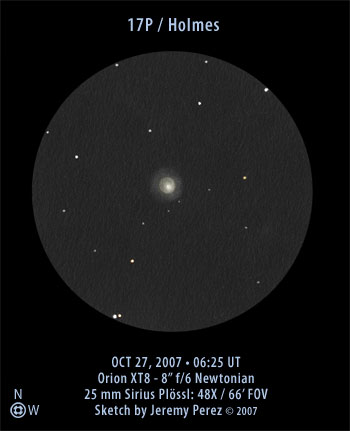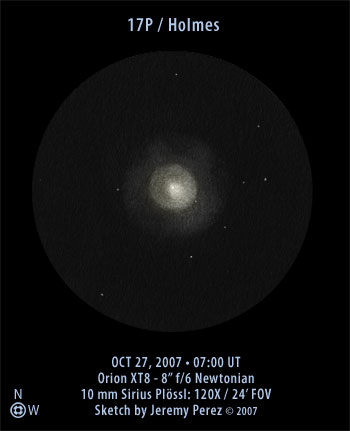
Move mouse over sketch above to view labels. Click image for larger version.

Move mouse over sketch above to view labels. Click image for larger version.
Observation Notes:
And it just keeps growing and growing and growing…
The comet’s naked eye brightness seems the same as the last two nights. With my stargazing glasses, it continues to be just shy of stellar–it’s just a bit blunt compared to nearby stars. Color through binoculars and the telescope is similar to yesterday–a warm ivory color. As it’s grown, features have become softer and more irregular.
The pseudo-nucleus is less prominent, but still distinctly stellar. The central fan structure is softer and still pointed at about 220 degrees PA. Further brightness around this fan makes me wonder if a second ring of material has been ejected and is slowly merging outward. The edges of the coma are both softer and also seem to have a scalloped appearance. Finally, the faint outer halo seems to have an irregular appearance to it–I still see the southwest side as being a bit brighter than the rest.
All the features have grown significantly. Measurements with my astrometric eyepiece yield:
- central condensation: 38 x 52 arc seconds
- coma: 215 arc seconds / 3.6 arc minutes
- outer halo: 585 arc seconds / 9.7 arc minutes
I wanted to keep my detail sketches consistently at the same scale, but the whole thing has gotten too big to continue the 240X/12 arc-minute-wide TFOV sketches. So I’ve dropped that down to 120X/24 arc-minute-wide TFOV. I was interested to find that the double star visible at the southeast side of the low power view has the designation ES 1064 (Espin). It’s fascinating to watch this beautiful comet develop. I can’t wait to see what happens to it in the coming days.
| Subject | 17P / Holmes |
| Classification | Comet |
| Position* | 8:15 UT – Perseus: 6:25 UT [RA: 03:50:55.7 / Dec: +50:17:41] 7:00 UT [RA: 03:50:54.3 / Dec: +50:17:47] |
| Size | Central condensation: 38 x 52 arc seconds Coma: 215 arc seconds / 3.6 arc minutes Outer halo: 585 arc seconds / 9.7 arc minutes |
| Brightness* | ~ 2.5 vMag |
| Date/Time | October 26, 2007, 11:25 PM – October 27, 2007, 12:00 AM (October 27, 2007, 06:25 – 07:00 UT) |
| Observing Loc. | Flagstaff, AZ – Home |
| Instrument | Orion XT8 (203 mm dia./1200 mm F/L) |
| Eyepieces/Mag. | 25 mm Sirius Plössl (48X) 10 mm Sirius Plössl + 2X Barlow (240X) 12 mm Meade Astrometric + 2X Barlow (~200X) |
| Conditions | Clear, calm, full moon |
| Seeing | 3/10 Pickering |
| Transparency | ~ Mag 4.5 NELM |
| *Sources | Aerith.net; Starry Night Pro Plus 5 |
*Based on published data.